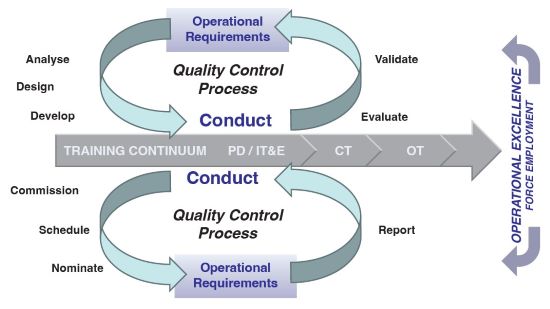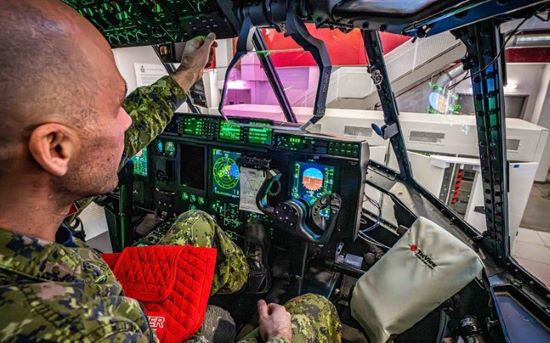Chapter 4: Operating Strategy
The operating strategy describes how the RCAF will train and how the training component of the RCAF's FG model aligns with other RCAF training stakeholders. It is therefore the capstone enabling strategy from which the TEL, training-management, OTI, and capability development, support and sustainment strategies flow.
Training Philosophy
Excellence in operations is achieved by infusing RCAF personnel with the necessary knowledge and attributes that are forged into skills. In turn, individuals are formed into crews/teams to provide a capability in accordance with the doctrine that describes how we fight. These crews/teams form operational units, most often as formed squadrons, but other operational units exist as well. Units or subunits are combined, at times, into air task forces for greater effect, as per RCAF expeditionary doctrine. This end-to-end concept is also known as the RCAF training spectrum or training continuum. The AFTS is thus designed to bring individuals into complex aerospace and joint CAF teams. Ultimately, the system forms force elements that can operate independently or as part of a Canadian or coalition air task force or joint task force.
By viewing training as a continuum, one can see how complexity increases as individuals progress through the system. As the complexity of tasks, skills and knowledge increases, so too does the diversity of training methods and technology. As one progresses along the continuum, more attention is given to real-life operations and individuals are trained to operate with excellence within teams in a demanding operating environment. This build approach is the essence of the RCAF's FG training philosophy.
(RCAF Strategy / RCAF CP –
Value our people and invest in their future; ready to conduct operations)
The training continuum is not linear. Individuals move back and forth along this continuum throughout their career to receive refresher and continuation training or to increase the level of training needed to fulfil operational needs. Progression and the development of a professional aviation cadre are also dependent on PD, which develops the knowledge and higher-level skills at key stages of an officer's or non-commissioned member's career to ensure success as a leader and supervisor. Whether derived from the CAF or RCAF, professional military education (PME) needs are delivered through a variety of formal methods. PME is essential to ensuring that the RCAF is effectively advancing an aviator/warrior/leader/manager model and preparing personnel to lead the profession of arms.
The RCAF Training FG Model
Like its counterparts in the Canadian Army and Royal Canadian Navy, the RCAF approach to training includes quality- and quantity-control processes to ensure the RCAF FG training requirements for individuals and teams are met efficiently and effectively. The quality-control process exists to ensure the design and delivery of training meets the requirements of operational excellence and supports military-occupational-structure progression. It is composed of six phases: training analysis, design, development, conduct, evaluation and validation. The quantity-control process exists to ensure intake as well as military-occupational-structure requirements are sufficient and that resources are identified early to ensure the RCAF's throughput requirements are met. The process includes the identification of personnel-training requirements, nomination, scheduling, matching, commissioning and funding. These quality- and quantity-control processes intersect in that both feed into the conduct of training. Many RCAF and departmental stakeholders are involved in these processes, and together they ensure the right training is being delivered to the right people at the right time. These processes inform the design and development of training, and they feed into as well as regulate the progression of individuals along the training continuum. Combined, they form the operating model of the FAFTS.

Figure 2. The RCAF approach to training.Footnote 3
Caption
The RCAF approach to training includes quality- and quantity-control processes to ensure the RCAF Force Generation training requirements for Individual Training and Education (IT&E) Collective Training (CT) and Operational training (OT) are met efficiently and effectively. The quality-control process exists to ensure the design and delivery of training meets the requirements of operational excellence and sup¬ports military-occupational-structure progression. It is composed of six phases: training analysis, design, development, conduct, evaluation and validation. The quantity-control process exists to ensure intake as well as military-occupational-structure requirements are sufficient and that resources are identified early to ensure the RCAF’s throughput requirements are met. The process includes the identification of personnel-training requirements, nomination, scheduling, matching, commissioning and funding. These quality- and quantity-control processes intersect in that both feed into the conduct of training. Many RCAF and departmental stakeholders are involved in these processes, and together they ensure the right training is being delivered to the right people at the right time. These processes inform the design and development of training, and they feed into as well as regulate the progression of individuals along the training continuum. Combined, they form the operating model of the Future Air Force Training System.

Caption
Over the shoulder photo of an RCAF aircraft technician manipulating cockpit controls inside a simulator for a CC-130J Hercules at 426 Transport Training Squadron, 8 Wing Trenton, Ontario.